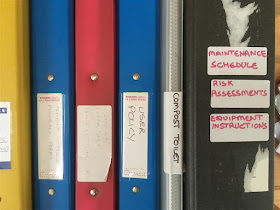Developed and managed by Marsh Street Arches and Garden Community Interest Company.
Pages
▼
Sunday, 22 December 2019
Tuesday, 17 December 2019
Making and using leaf mould
Making and using leaf mould:
After collecting fallen leaves place them in a bin liner, moisten them if they are dry, then pierce holes in the
bag with a knife or garden fork, tie the top loosely and stack the bags out of
sight for up to two years.
Well-rotted leaf mould over two years old can be
used as seed-sowing compost, garden compost and good quality soil for use as
potting compost.
Leaf mould, less than two years old can be used as mulch,
a soil conditioner, or a winter covering for bare soil.
A quiet time of the year, but there is always something to do in the garden
December can
be a relatively quiet time on the garden but there are always a few jobs you
can be getting on with. For example:
Digging over
and prepare your soil for next year’s planting and growing season. At the same
time you can add organic matter such as well rotted manure and/or contents from
your compost bin.
Cleaning bird feeders, stock up on fat balls and making sure birds have access to fresh water.
Making a log pile or mini beast hotel which will help to provide
shelter for wildlife.
Washing, cleaning and servicing all of your garden tools and giving them a wipe with oil to help prevent
rusting.
Pruning and trimming fruit trees and hedging.
Turning over your compost heaps to let air in and
then covering them with a piece of old carpet or some plastic sheeting to prevent the compost becoming too cold and wet to rot down.
Collecting fallen leaves and
adding them to the compost bin and/or
save separately to make leaf mould.
Removing weeds and adding
them to the compost bin.
Clearing any fallen or diseased fruit.
And from the warmth and comfort of your armchair you could perhaps begin planning for next year.
And from the warmth and comfort of your armchair you could perhaps begin planning for next year.
Wednesday, 11 December 2019
Sunday, 20 October 2019
Thursday, 10 October 2019
Saturday, 28 September 2019
Friday, 27 September 2019
Thursday, 19 September 2019
Monday, 16 September 2019
A little early morning maintenance
Cleaning the air box, replacing the missing air filter on the mower and lubricating some of the padlocks.
Sunday, 15 September 2019
One of our inhabitant common lizards on the wildlife friendly area
A year in the life of a common lizard…
Spring - Adult lizards emerge from their hibernation sites in early spring. Mating takes place around April.
Summer - Females incubate the eggs inside themselves and ‘give birth’ to up to 11 live young around July/August. Juvenile lizards are tiny – less than 5cm long – and are darker in colour than the adults.
Autumn - Lizards spend the next couple of months feeding up on invertebrates in preparation for winter. They feed on worms, slugs and insects and give their prey a good shake, to stun it, before swallowing.
Winter - Common Lizards hibernate, often in groups, amongst rocks or dead wood generally between November and March. They may take advantage of milder patches of weather to come out and forage.
Common Lizards are protected under the Wildlife and Countryside Act 1981. It is an offence to kill, harm or injure them sell or trade them in any way
Wednesday, 4 September 2019
Tuesday, 3 September 2019
Free trees from the Woodland Trust
The Woodland Trust want to make sure everyone in the UK has
the chance to plant a tree. So they are giving away hundreds of thousands of
trees to schools and communities.
For more information and details of how to apply please visit their website here.
Monday, 2 September 2019
Saturday, 10 August 2019
Friday, 9 August 2019
Wednesday, 26 June 2019
Tuesday, 25 June 2019
Wednesday, 12 June 2019
Monday, 3 June 2019
Vipers bugloss, ox eye daisy and buttercup on the wildlife friendly area
Vipers bugloss is a good source of food for a large variety of insects including; bumblebees, honey bees, painted lady and large skipper butterflies.



















































